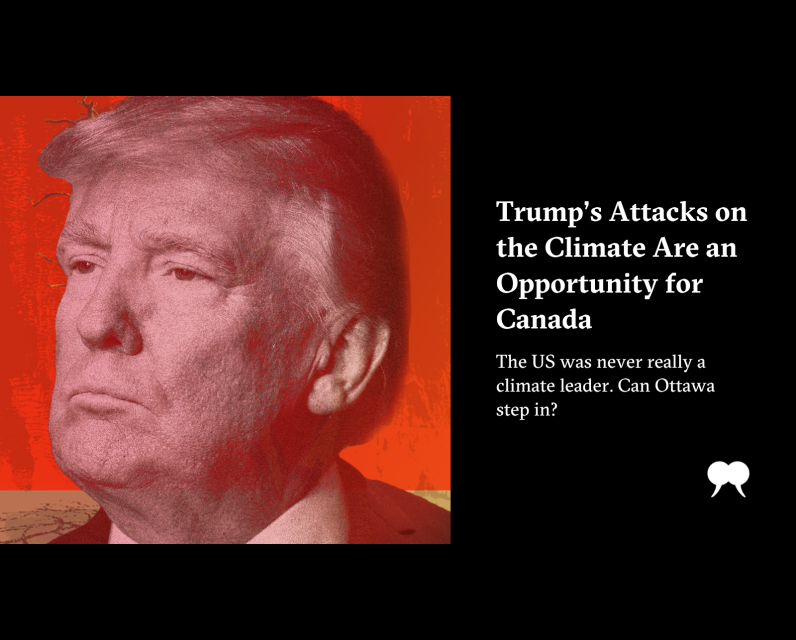Trump’s Attacks on the Climate Are an Opportunity for Canada

O n the first day of Donald Trump’s second term in office, he pulled the United States out of the Paris Agreement—for the second time. Two weeks later, he began purging anything to do with climate change from US government websites. Five months after that, he knifed the fossil fuel industry’s competition with the One Big Beautiful Bill Act, signed into law on July 4. That bill cancels most of the tax credits for renewable energy production that had been established under former president Joe Biden’s Inflation Reduction Act. According to the UK-based climate organization Carbon Brief, Trump’s bill will add 7 billion tonnes of greenhouse gases to US emissions over the next five years—equivalent to 4 percent of global emissions. If the bill were a country, it would be the world’s sixth biggest climate polluter.
The bill is only an opening act. The Trump administration isn’t just waging war on clean energy; it’s demolishing every climate policy and institution in the nation, from the Environmental Protection Agency’s curbs on power plant emissions to the National Oceanic and Atmospheric Administration’s vast climate research wing—the backbone of global climate science.
“This is not just a little haircut for a large federal agency,” wrote geochemist Ralph Keeling of the looming NOAA cuts. Keeling is the son of Dave Keeling, the first scientist to measure atmospheric carbon dioxide, after whom the Keeling Curve (a graph depicting the steady increase in atmospheric CO2 since 1958) is named. “It’s grabbing the scissors and stabbing the agency through the heart.” Republicans proudly agree. “We are driving a dagger straight into the heart of the climate change religion,” Lee Zeldin, the Trump-appointed head of the EPA, declared on March 12. At the end of July, after the EPA announced it intends to stop regulating greenhouse gases altogether, Zeldin said, “There are people who, in the name of climate change, are willing to bankrupt the country.”
A full list of Trump’s ruthless assaults on climate action would fill a book. Some of these wounds have already been inflicted; many await the federal budget, which usually passes in the fall. Perhaps some shreds of US climate policy will survive that budget, and this administration, but it’s clear that America’s flirtation with climate leadership is over. The most powerful country on earth is now the world’s leading denier of climate change.
If there is any silver lining, it’s that the veil has finally, and irrevocably, been torn off the idea of American climate leadership. For all its contributions to climate science, the US has been scuppering global climate action for much longer than Trump has been in politics. George W. Bush pulled America out of the Kyoto Protocol in 2001. Even though Barack Obama rallied world leaders to join the Paris Agreement in 2015 and pledged to limit global warming to less than two degrees, he also presided over the biggest explosion of oil and gas production in American history. By the time Trump pulled the country out of the Paris Agreement in 2017, the US was the world’s leading oil and gas producer—a position it has held ever since. In 2021, Biden signed back on to the Paris Agreement, and then Trump pulled out again.
This pattern summons the image of Lucy promising Charlie Brown that this time, she’ll let him kick the football. Perhaps now we can stop playing that game.
It’s always been a stretch to imagine the US as a climate leader. No country has ever had higher per capita emissions than America; collectively, it was the world’s number one emitter until 2005—right around the time its oil and gas production went through the roof. The US still holds the number two position. Ironically, the country that took its place—China—simultaneously became the leader of the global energy transition.
An explosion of coal-fired power plants was part of the price of delivering 800 million Chinese citizens out of extreme poverty over the past forty years. But even as it burned that coal, China became the world’s leading producer of wind and solar energy as well as electric vehicles, all of which it is exporting to the rest of the world. As Bill McKibben recently wrote in The New Yorker, “Seven Chinese companies that I’d wager most Americans have never heard of—Tongwei, GCL Technology Holdings, Xinte Energy, Longi, Trina Solar, JA Solar Technology, and JinkoSolar—produced more energy in 2024 than the seven global giants at the heart of Big Oil.”
China’s global dominance of clean energy may be insurmountable. But the US abandonment of renewables does present an opportunity for Canada—to say nothing of the climate crisis, which has only gotten worse in the ten years since we signed the Paris Agreement. Our new prime minister is clearly aware of this. His speech from the throne expressed a desire for “Canada to become the world’s leading energy superpower in both clean and conventional energy,” a sentiment he’s repeated frequently since. One wishes he’d drop “conventional” (i.e., fossil fuel) from that formulation, but even so: just half a year into the Trump administration, and just over three months since Mark Carney was elected, the outlines of a transition within the transition are coming into view.
Renewable energy will comprise a significant number of the “major projects” to be streamlined under Carney’s signature legislation, Bill C-5, according to reporting from Canada’s National Observer. In parallel, securing “critical mineral supply chains”—that is, the metals required for clean energy production and storage, of which Canada has enormous reserves—has emerged as a key priority for the Carney government. He made it a dominant theme at the G7 summit in June. Soon afterward, he named critical minerals as a major component of the increased North Atlantic Treaty Organization military spending he committed Canada to in Brussels.
In Carney’s telling, our vast supply of critical minerals provides several opportunities at once: Canada and its NATO allies need them for everything from batteries to war planes; the cost of building export infrastructure will count toward our NATO tab; there’s money to be made, jobs galore, and the promise of true “energy sovereignty” that comes with developing our own clean power.
Still, at this early stage, Canada’s potential is only that—potential. For all Carney’s talk of clean energy, he’s giving just as much encouragement to that other kind. So it’s too early to tell whether Canada will seize this moment or simply maintain its position as the world’s fourth biggest producer of oil while running a few wind farms on the side.
What a missed opportunity that would be. With or without us, much of the world is moving ahead. Global clean energy production and use—from wind and solar power to electric vehicles—are scaling up exponentially, for reasons Trump can do nothing about. Solar power is now the cheapest source of electricity for much of the planet. At the same time, huge advances in storage technology are taking care of the “what happens when the sun doesn’t shine” problem. Then there’s the independence that renewables provide: nobody wants to rely on Russia, Saudi Arabia, or America for power if they don’t have to.
That said, it remains true, as the fossil fuel industry keeps reminding us, that the global consumption of oil, gas, and coal is going up, not down. So are emissions and global temperatures. That’s because of something known as the addition problem: no matter how fast we grow our clean energy production, the world’s overall energy demand grows faster. Instead of replacing fossil fuel, renewable energy is added to it.
The only times this century that global emissions have actually gone down were in 2020, when they plummeted by 4.6 percent because the COVID-19 pandemic forced a temporary shutdown of the global economy, and in 2009, after the global financial crisis caused a temporary 1.4 percent drop in global emissions. In both cases, emissions returned to new highs as soon as economic growth resumed.
There’s a sliver of hope, too, in that trend. Economic growth fuels climate change. But one of the greatest threats to economic growth today is Donald Trump. By triggering a recession, in America or beyond, Trump could inadvertently contribute to lowering greenhouse gas emissions. It would only be temporary, assuming the world economy bounces back, but at this critical stage of tipping points and Paris-target deadlines, it could buy us precious time.
It’s darkly comical to think that Trump’s obsession with tariffs, the trillions he keeps adding to the national debt, and his refusal to acknowledge the rising costs of extreme weather could deliver a climate bonus. Of course, it’s the worst possible way to lower emissions. But, so far, it’s the only one that’s proven to work.
With thanks to the Trottier Foundation for helping The Walrus publish writing on climate change and the environment.
The post Trump’s Attacks on the Climate Are an Opportunity for Canada first appeared on The Walrus.

Comments
Be the first to comment